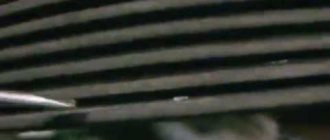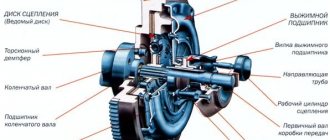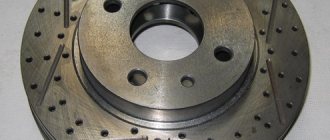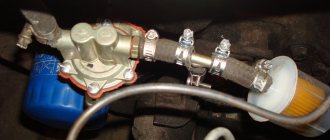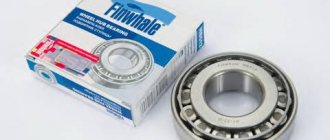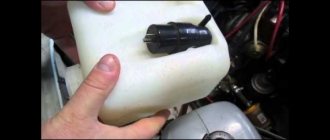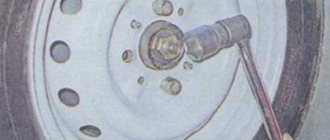Earbuds
No adjustment operations should be performed on the liners. If there are scuffs, marks or peeling, replace the liners with new ones.
The gap between the liners and the crankshaft journals is checked by calculation (by measuring the parts). It is convenient to use a calibrated plastic wire to check the gap. In this case, the verification method is as follows:
- thoroughly clean the working surfaces of the liners and the corresponding neck and place a piece of plastic wire on its surface;
- Install a connecting rod with a cap or a main bearing cap on the journal (depending on the type of journal being tested) and tighten the fastening nuts or bolts. Tighten the connecting rod bolt nuts to a torque of 51 Nm (5.2 kgf m), and the main bearing cap bolts to a torque of 80.4 Nm (8.2 kgf m);
- remove the cover and use the scale on the package to determine the size of the gap by flattening the wire (Fig. 2-38).
The nominal design clearance is 0.02-0.07 mm for connecting rods and 0.026-0.073 mm for main journals. If the gap is less than the limit (0.1 mm for connecting rods and 0.15 mm for main journals), then these liners can be used again.
If the gap is greater than the limit, replace the liners on these necks with new ones.
If the crankshaft journals are worn and ground to repair size, then replace the bearings with repair bearings (of increased thickness).
Repair dimensions of cylinders and pistons of the VAZ 21213 engine during major repairs
| Repair cylinder size, mm | Piston and cylinder class | Piston diameter, mm | Cylinder diameter after boring, mm | Cylinder diameter after honing, mm |
| 1 repair | ||||
| 82,4 | A | 82,34-82,35 | 82,37-82,38 | 82,40-82,41 |
| B | 82,35-82,36 | 82,38-82,39 | 82,41-82,42 | |
| C | 82,36-82,37 | 82,39-82,40 | 82,42-82,43 | |
| D | 82,37-82,38 | 82,40-82,41 | 82,43-82,44 | |
| E | 82,38-82,39 | 82,41-82,42 | 82,44-82,45 | |
| 2 repairs | ||||
| 82,8 | A | 82,74-82,75 | 82,77-82,78 | 82,80-82,81 |
| B | 82,75-82,76 | 82,78-82,79 | 82,81-82,82 | |
| C | 82,76-82,77 | 82,79-82,80 | 82,82-82,83 | |
| D | 82,77-82,78 | 82,80-82,81 | 82,83-82,84 | |
| E | 82,78-82,79 | 82,81-82,82 | 82,84-82,85 | |
Also interesting: Characteristics of the NIVA 2121 engine - Shop of auto parts and accessories for Niva and NIVA-Chevrolet cars
Thrust half rings
Just like on the liners, no adjustment operations can be performed on the half rings. If there are burrs, marks or peeling, replace the half rings with new ones.
Half rings are also replaced if the axial clearance of the crankshaft exceeds the maximum permissible - 0.35 mm. Select new half rings with a nominal thickness or increased by 0.127 mm to obtain an axial clearance in the range of 0.06-0.26 mm.
The axial clearance of the crankshaft is checked using an indicator, as described in the chapter “Engine Assembly” (Fig. 2-14).
The crankshaft axial clearance can also be checked with the engine installed in the vehicle. In this case, the axial movement of the crankshaft is created by pressing and releasing the clutch pedal, and the amount of clearance is determined by the movement of the front end of the crankshaft.
Weaknesses of the VAZ 21213 power unit
- Water pump;
- Engine, manual transmission and transfer case oil seals;
- Generator;
- Starter;
- manual transmission;
- Valve cover gasket;
- Cooling system pipe connections;
- Radiator;
- Thermostat;
- Expansion tank;
- Vacuum brake booster.
The water pump (pump) is characterized by frequent failures on new cars after 2,000 km.
Due to poor quality, oil seals require more frequent replacement than required according to the operating manual.
The generator has a high probability of failure. As a rule, it burns out even on new cars that have not reached 4,000-10,000 km.
The starter has a low service life without repair.
On a gearbox, one of the common defects is the fifth gear slipping out. In addition, the gears are not fully engaged.
The valve cover gasket loses its properties over time and allows oil to leak out.
Also interesting: Changing the oil in the front and rear axles of a VAZ Niva
The connections of the cooling system pipes in the places where the clamps are installed are not reliable and lose their tightness very early, which is fraught with loss of antifreeze.
The radiator is leaking. The problem occurs due to the appearance of cracks in the radiator pipe package, accompanied by loss of coolant. This defect has become widespread.
The thermostat does not provide thermal conditions for the coolant in the engine cooling system. The manifestation of this problem is no exception. The cause of the defect is a failure of the valve mechanism inside the thermostat. To check that the thermostat is working properly, after starting the engine, simply place your palm on the lower (outlet) hose, through which hot antifreeze circulates into the radiator for cooling. If the thermostat is working properly, after some time the hose should become hot; if the hose remains cold, the thermostat must be replaced.
The expansion tank cracks and antifreeze leaks out. The appearance of cracks occurs due to the failure of the steam-air valve in the tank plug due to increased pressure.
Vacuum brake booster (VUT). Manifested by a stiff brake pedal. The speed may fluctuate when the brake pedal is pressed, as well as hissing. The problem is solved by replacing failed rubber products and replacing clamps in connections.
- Vibration at speed 80-90 km;
- Unreliable timing tensioner design;
- Ignition module;
- The fuel pump is noisy;
- Low torque;
- Long stroke of the gear lever;
- When the timing chain breaks, the valves bend;
- Vibration of the gear lever;
- Poor dynamics on the highway due to insufficient power.
PS. Dear Nivovody! I look forward to your comments, questions and feedback on the problems that have arisen, weaknesses and shortcomings during the operation, maintenance and repair of the VAZ 21213 engine.
Product added to bookmarks!
- Description
- Reviews
Standard crankshaft from the VAZ 2130 1.8L engine (OPP VAZ).
A crankshaft with a stroke of 84 mm (cast iron) is installed in the VAZ 21213 (Niva) and VAZ 2123 (Niva-Chevrolet, CHEVROLET NIVA) block together with
TDMK pistons (82.0 mm - 82.4 mm - 82.8 mm - 84.0 mm), with standard or lightweight connecting rods.
This crankshaft can be installed in the block of a VAZ 2103 (1.5L) and VAZ 2106 (1.6L) without replacing connecting rods and pistons (an accurate calculation of the compression ratio and adjustment of the combustion chamber will be required).
You can increase the engine displacement by: replacing the crankshaft with another one with a larger stroke, increasing the cylinder diameter, or both at the same time. We must not forget that when changing engine volume, it is necessary to increase the volume of the combustion chamber - to compensate for the increase in cylinder volume.
When installing a crankshaft with a long stroke, it is necessary to replace the pistons.
Boring the block cylinders by a significant amount (2 mm) must be approached with caution. For example, when a serial VAZ 21083 block is bored from 82 mm to 84 mm, the engine experiences increased oil consumption. This occurs due to the loss of block rigidity. In this case, it is better to use a special thick-walled block casting. VAZ produces such blocks in small batches.
An increase in engine displacement leads to an increase in maximum torque , but at the same time there is a decrease in maximum power speed. This is due to a decrease in mechanical efficiency. If the increase in volume occurs due to an increase in the diameter of the cylinders, then the contact area between the cylinder walls and the piston with piston rings increases. As a result, friction increases. If the increase in volume occurs due to an increase in the crankshaft stroke, then the average piston speed increases, which leads to the same results.
In any case, an increase in volume leads to a drop in the overall efficiency of the engine.
VAZ engine volume (in cubic cm) depending on the cylinder diameter and piston stroke.
Diameter Stroke, mm cylinder, 80 84 86 88 mm 76.0 1451 1524 1560 1596 76.4 1466 1540 1576 1613 76.8 1476 1556 1593 1630 79.0 1568 1646 1685 17 25 79.4 1584 1663 1702 1742 79.8 1600 1680 1720 1760 80.0 1608 1688 1628 1768 82.0 1689 1774 1816 1858 82.4 1706 1791 1834 1876 82.8 1722 1808 1851 1894 84, 0 1772 1861 1905 1950
Technical characteristics of the VAZ-21213 cylinder block
The cylinder block of the VAZ-21213 engine has the following dimensions:
| Size, mm | Maximum tolerance, mm | |
| Diameter of one cylinder | 82 | 0.05 mm |
| Block height (from the top plane to the crankshaft axis) | 214.58 | 0.15 |
| Intercylinder distance | 95 | — |
| Crankshaft support bore diameter | 54.52 | 0.013 |
There are five size classes, each of which is assigned a specific letter of the Latin alphabet - from A to E. For the VAZ-21213, each of the classes has a gap of 0.010 mm - from 82.0 .. 82.010 mm for class A to 82.040 ... 82.050 for class E.
For pistons, standard alphanumeric markings are used with the designation of the size group (A-E), the class of diameter of the hole for the piston pin (from 1 to 3), as well as an arrow - it indicates the direction to the front of the engine.
Description
In 1994, VAZ engine builders developed and put into production a new (at that time) engine, designated VAZ-21213. Its design took place in parallel with the creation of the engine for the Lada VAZ-2107, but installation priority was given to Niva SUVs.
The VAZ-21213 engine is an in-line four-cylinder naturally aspirated petrol engine with a volume of 1.7 liters and a power of 78.9 hp. s and torque 127 Nm.
Installed on Lada cars:
- 2129 (1994-1996);
- 4x4 Niva 2121 (1997-2019);
- 4x4 Bronto (1995-2011);
- Niva Pickup (1995-2019).
Additionally, it can be found under the hood of Lada Nadezhda, Lada 21213 and Lada 21313. On Ladas 21214, 21044 and 21074 it was exported abroad.
Many car enthusiasts are confident that the VAZ-21213 is nothing more than a “bored” VAZ-2121. This opinion is wrong. The fact is that the VAZ-21213 is a completely new development. When creating it, innovative technologies used in the classic 2101-2106, diesel and front-wheel drive 2108 were used.
The cylinder block is traditionally cast iron, not lined. There are five crankshaft bearings at the bottom. The main bearing shells are steel-aluminum. The block has two repair sizes - 82.4 and 82.8. Thus, the internal combustion engine of the VAZ-21213 can be painlessly made two major repairs.
The crankshaft is made of high-strength cast iron. It has eight counterweights to reduce second-order inertial forces that cause engine vibration. A timing drive sprocket and a drive pulley for attachments (pump, generator, power steering) are installed on the toe of the crankshaft. The flywheel is attached to the opposite side.
On the left is the VAZ-2103 crankshaft, on the right is the VAZ-21213
The connecting rods are steel. The bearings (liners) of the lower head are made of steel-aluminium, the upper one is made of steel-bronze bushing. Due to the very small gap in the liners, misalignment of the connecting rod cap during assembly is not allowed, otherwise problems with lubrication of the bearings will arise. The upper head is made for a floating piston pin.
The pistons are original, aluminum, with three rings, two of which are compression, one is oil scraper. The recess in the bottom is an additional combustion chamber (the main one is located in the cylinder head). The piston pin is of a floating type, secured by two retaining rings.
The cylinder head is original, aluminum. Equipped with one camshaft and 8 valves. Hydraulic valve compensators are not provided, so the thermal gap has to be adjusted manually every 7-10 thousand kilometers. A disposable metal-reinforced gasket is installed between the block and the head.
The camshaft is cast from cast iron. Mounted on five supports. It has a specially shaped cams that ensure longer opening of the intake valves. This innovation leads to improved filling of the combustion chamber with the working mixture, which in turn increases the power of the power unit.
Timing chain drive. To improve performance, a new tensioner design with an extended shoe is used. The stretching of the chain causes the valves to bend and the piston to break when they come into contact.
Combined lubrication system. Gear type oil pump.
The original oil recommended by the manufacturer is Lukoil Lux 10W-30 or 10W-40. Among non-original ones, preference can be given to domestic brands Rosneft, G-Energy and Gazpromneft.
The fuel supply system is carburetor. An innovation is the use of the 21073 Solex carburetor.
The ignition system is contactless with one common high-voltage coil. Recommended spark plugs are AU17DVRM or BCPR6ES (NGK).
The remaining systems and components remained classic.
Price of new and contract engine 21213
Drivers of Niva with engine 21213 note the affordable price of spare parts and the car as a whole as one of their selection criteria. A new fully equipped engine with a factory warranty will cost 70,000 rubles. For comparison, the price of the injection 21214 is from 85,000 rubles.
A used engine costs 2 times less: 30 - 45,000 rubles. There are models for 10-15,000 rubles, but their condition, as a rule, requires repair.
